Improved Insulating Properties of Polymer Dielectric by Constructing Interfacial Composite Coatings
Abstract
:1. Introduction
2. Experimental Section
2.1. Materials
2.2. Sample Preparation
2.3. Material Characterization and Electrical Properties
3. Results and Discussion
3.1. Characterization
3.2. DC Breakdown Strength
3.3. High Field Conductance Characteristics
3.4. Trap Distribution Characteristics
4. Relation between Trap Properties and DC Breakdown
5. Conclusions
Author Contributions
Funding
Institutional Review Board Statement
Informed Consent Statement
Data Availability Statement
Conflicts of Interest
References
- Resner, L.; Lesiak, P.; Taraghi, I.; Kochmanska, A.; Figiel, P.; Piesowicz, E.; Zenker, M.; Paszkiewicz, S. Polymer Hybrid Nanocomposites Based on Homo and Copolymer Xlpe Containing Mineral Nanofillers with Improved Functional Properties Intended for Insulation of Submarine Cables. Polymers 2022, 14, 3444. [Google Scholar] [CrossRef] [PubMed]
- Huang, X.; Zhang, J.; Jiang, P.; Tanaka, T. Material Progress toward Recyclable Insulation of Power Cables Part 2: Polypropylene-Based Thermoplastic Materials. IEEE Electr. Insul. Mag. 2020, 36, 8–18. [Google Scholar] [CrossRef]
- Der, O.; Edwardson, S.; Marengo, M.; Bertola, V. Engineered Composite Polymer Sheets with Enhanced Thermal Conductivity. IOP Conf. Ser. Mater. Sci. Eng. 2019, 613, 012008. [Google Scholar] [CrossRef]
- Zhao, J.; Zhao, Q.; Wang, C.; Guo, B.; Park, C.B.; Wang, G. High Thermal Insulation and Compressive Strength Polypropylene Foams Fabricated by High-Pressure Foam Injection Molding and Mold Opening of Nano-Fibrillar Composites. Mater. Des. 2017, 131, 1–11. [Google Scholar] [CrossRef]
- Zhang, Y.; Wu, Z.; He, J.; Zhang, D.; Hu, M. Electrical Treeing Behaviours in Cross-linked Polyethylene Cables after Thermal Ageing. High Volt. 2023, 8, 749–759. [Google Scholar] [CrossRef]
- He, X.; Seri, P.; Rytoluoto, I.; Anyszka, R.; Mahtabani, A.; Naderiallaf, H.; Niittymaki, M.; Saarimaki, E.; Mazel, C.; Perego, G.; et al. Dielectric Performance of Silica-Filled Nanocomposites Based on Miscible (PP/PP-HI) and Immiscible (PP/EOC) Polymer Blends. IEEE Access 2021, 9, 15847–15859. [Google Scholar] [CrossRef]
- Umemoto, T.; Yoshida, S.; Muto, H.; Kurimoto, M. Critical Agglomerate Size for Electrical Insulation Lifetime Extension of Epoxy/TiO2 Nanocomposite with a Void Defect. IEEE Trans. Dielectr. Electr. Insul. 2021, 28, 282–289. [Google Scholar] [CrossRef]
- Zhang, X.; Wang, M.; Gao, J.; Guo, N. Crystallization Morphology and Space Charge Property of Silica/Low Density Polyethylene Composites. AIP Adv. 2020, 10, 015043. [Google Scholar] [CrossRef]
- Danikas, M.G.; Tanaka, T. Nanocomposites-a Review of Electrical Treeing and Breakdown. IEEE Electr. Insul. Mag. 2009, 25, 19–25. [Google Scholar] [CrossRef]
- Bilisik, K.; Akter, M. Polymer Nanocomposites Based on Graphite Nanoplatelets (GNPs): A Review on Thermal-Electrical Conductivity, Mechanical and Barrier Properties. J. Mater. Sci. 2022, 57, 7425–7480. [Google Scholar] [CrossRef]
- Mansour, D.-E.A.; Abdel-Gawad, N.M.K.; El Dein, A.Z.; Ahmed, H.M.; Darwish, M.M.F.; Lehtonen, M. Recent Advances in Polymer Nanocomposites Based on Polyethylene and Polyvinylchloride for Power Cables. Materials 2020, 14, 66. [Google Scholar] [CrossRef]
- Mohammed, M.I. Controlling the Optical Properties and Analyzing Mechanical, Dielectric Characteristics of MgO Doped (PVA–PVP) Blend by Altering the Doping Content for Multifunctional Microelectronic Devices. Opt. Mater. 2022, 133, 112916. [Google Scholar] [CrossRef]
- Naveen, J.; Sukesh Babu, M.; Sarathi, R.; Velmurugan, R.; Danikas, M.G.; Karlis, A. Investigation on Electrical and Thermal Performance of Glass Fiber Reinforced Epoxy–MgO Nanocomposites. Energies 2021, 14, 8005. [Google Scholar] [CrossRef]
- Soroudi, A.; Ouyang, Y.; Nilsson, F.; Östergren, I.; Xu, X.; Li, Z.; Pourrahimi, A.M.; Hedenqvist, M.; Gkourmpis, T.; Hagstrand, P.-O.; et al. Highly Insulating Thermoplastic Nanocomposites Based on a Polyolefin Ternary Blend for High-Voltage Direct Current Power Cables. Nanoscale 2022, 14, 7927–7933. [Google Scholar] [CrossRef]
- Abdelsalam, A.A.; Ward, A.A.; Abdel-Naeem, G.; Mohamed, W.S.; El-Sabbagh, S.H. Effect of Alumina Modified by Silane on the Mechanical, Swelling and Dielectric Properties of Al2O3/EPDM/SBR Blend Composites. Silicon 2023, 15, 3609–3621. [Google Scholar] [CrossRef]
- Zhang, J.; Liu, H.; Yang, H.; Dong, X.; Liu, S.; Diao, T.; Li, Y. Space Charge Characteristics of Nano-SiO2-Modified Oil-Paper Insulation and Numerical Simulation. J. Mater. Sci. Mater. Electron. 2022, 33, 16251–16262. [Google Scholar] [CrossRef]
- Adnan, M.M.; Ve, T.A.; Hvidsten, S.; Ese, M.-H.G.; Glaum, J.; Einarsrud, M.-A. Electrical Treeing and Partial Discharge Behavior in Epoxy Nanocomposites With In Situ Synthesized SiO2. IEEE Trans. Dielectr. Electr. Insul. 2023, 30, 936–945. [Google Scholar] [CrossRef]
- Li, Z.; Su, J.; Du, B.; Hou, Z.; Han, C. Inhibition Effect of Graphene on Space Charge Injection and Accumulation in Low-Density Polyethylene. Nanomaterials 2018, 8, 956. [Google Scholar] [CrossRef]
- Díez-Pascual, A.M. Development of Graphene-Based Polymeric Nanocomposites: A Brief Overview. Polymers 2021, 13, 2978. [Google Scholar] [CrossRef]
- Basirun, W.J.; Saeed, I.M.; Rahman, M.S.; Mazari, S.A. Nickel Oxides/Hydroxides-Graphene as Hybrid Supercapattery Nanocomposites for Advanced Charge Storage Materials—A Review. Crit. Rev. Solid State Mater. Sci. 2021, 46, 553–586. [Google Scholar] [CrossRef]
- Du, B.X.; Li, J. Interface Charge Behaviors between LDPE and EPDM Filled with Carbon Black Nanoparticles. IEEE Trans. Dielectr. Electr. Insul. 2016, 23, 3696–3703. [Google Scholar] [CrossRef]
- Payandehpeyman, J.; Mazaheri, M.; Zeraati, A.S.; Jamasb, S.; Sundararaj, U. Physics-Based Modeling and Experimental Study of Conductivity and Percolation Threshold in Carbon Black Polymer Nanocomposites. Appl. Compos. Mater. 2023. [Google Scholar] [CrossRef]
- Kumar, V.; Alam, M.N.; Manikkavel, A.; Song, M.; Lee, D.-J.; Park, S.-S. Silicone Rubber Composites Reinforced by Carbon Nanofillers and Their Hybrids for Various Applications: A Review. Polymers 2021, 13, 2322. [Google Scholar] [CrossRef]
- Nagaraju, G.; Velmurugan, R.; Sarathi, R.; Tanaka, T. Understanding the Interfacial and Agglomeration Impact in Epoxy Nanocomposites on Its Electrical and Mechanical Properties. Electr. Eng. 2022, 104, 2141–2153. [Google Scholar] [CrossRef]
- Khan, M.Z.; Nazir, M.S.; Bhutta, M.S.; Wang, F. Fluorination Treatment and Nano-Alumina Concentration on the Direct Current Breakdown Performance & Trap Levels of Epoxy/Alumina Nanocomposite for a Sustainable Power System. Sustainability 2023, 15, 5826. [Google Scholar] [CrossRef]
- Zarei Darani, S.; Naghdabadi, R. An Experimental Study on Multiwalled Carbon Nanotube Nanocomposite Piezoresistivity Considering the Filler Agglomeration Effects. Polym. Compos. 2021, 42, 4707–4716. [Google Scholar] [CrossRef]
- He, X.; Rytöluoto, I.; Anyszka, R.; Mahtabani, A.; Saarimäki, E.; Lahti, K.; Paajanen, M.; Dierkes, W.; Blume, A. Surface Modification of Fumed Silica by Plasma Polymerization of Acetylene for PP/POE Blends Dielectric Nanocomposites. Polymers 2019, 11, 1957. [Google Scholar] [CrossRef]
- Belov, N.A.; Pashkevich, D.S.; Alentiev, A.Y.; Tressaud, A. Effect of Direct Fluorination on the Transport Properties and Swelling of Polymeric Materials: A Review. Membranes 2021, 11, 713. [Google Scholar] [CrossRef]
- Zhao, A.; Chen, X.; Chen, S.; Yao, C.; Zhao, X.; Deng, J.; Zhang, G. Surface Modification of XLPE Films by CF4 DBD for Dielectric Properties. AIP Adv. 2019, 9, 015102. [Google Scholar] [CrossRef]
- Li, Y.; Hao, J.; Liao, R.; Ye, W.; Liu, C.; Yang, L. Charge Injection Suppression and Breakdown Strength Enhancement of Cellulose Pressboard via Al2O3 /PTFE Functional Film Depositing. IEEE Trans. Dielectr. Electr. Insul. 2022, 29, 1011–1021. [Google Scholar] [CrossRef]
- Hallett, L.; Charaev, I.; Agarwal, A.; Dane, A.; Colangelo, M.; Zhu, D.; Berggren, K.K. Superconducting MoN Thin Films Prepared by DC Reactive Magnetron Sputtering for Nanowire Single-Photon Detectors. Supercond. Sci. Technol. 2021, 34, 035012. [Google Scholar] [CrossRef]
- Saman, N.M.; Ahmad, M.H.; Buntat, Z. Application of Cold Plasma in Nanofillers Surface Modification for Enhancement of Insulation Characteristics of Polymer Nanocomposites: A Review. IEEE Access 2021, 9, 80906–80930. [Google Scholar] [CrossRef]
- Zhu, X.; Xu, J.; Cui, X.; Zhou, R.; Zhou, R.; Liu, F.; Fang, Z.; Cullen, P.J.; Ostrikov, K. Plasma-Electrified Repair of Damaged Polymer Composites for Surface Crack Healing and Insulation Recovery. Chem. Eng. J. 2022, 449, 137754. [Google Scholar] [CrossRef]
- Zhou, Y.; Li, Q.; Dang, B.; Yang, Y.; Shao, T.; Li, H.; Hu, J.; Zeng, R.; He, J.; Wang, Q. A Scalable, High-Throughput, and Environmentally Benign Approach to Polymer Dielectrics Exhibiting Significantly Improved Capacitive Performance at High Temperatures. Adv. Mater. 2018, 30, 1805672. [Google Scholar] [CrossRef]
- Abessolo Ondo, D.; Loyer, F.; Boscher, N.D. Influence of Double Bonds and Cyclic Structure on the AP-PECVD of Low- k Organosilicon Insulating Layers. Plasma Process. Polym. 2021, 18, 2000222. [Google Scholar] [CrossRef]
- Bellomo, N.; Michel, M.; Pistillo, B.R.; White, R.J.; Barborini, E.; Lenoble, D. Chemical Vapor Deposition for Advanced Polymer Electrolyte Fuel Cell Membranes. ChemElectroChem 2022, 9, e202101019. [Google Scholar] [CrossRef]
- Meng, F.-B.; Chen, X.; Shi, Y.; Hong, Z.; Zhu, H.; Muhammad, A.; Li, H.; Paramane, A. Spraying EPDM@NPs as an Efficient Strategy for Polyethylene-Based High-Voltage Insulation. Chem. Eng. J. 2023, 451, 138874. [Google Scholar] [CrossRef]
- Wang, T.; Liu, S.; Li, X.; Wang, Q.; Liu, S.; Liang, X.; Li, S.; Liu, B.; Liu, J.; Zhang, G. Wide Bandgap Nanocoatings for Polymer Dielectric with Outstanding Electrical Strength. Adv. Mater. Interfaces 2022, 9, 2201824. [Google Scholar] [CrossRef]
- Xu, X.; Mo, L.; Li, Y.; Pan, X.; Hu, G.; Lei, B.; Zhang, X.; Zheng, M.; Zhuang, J.; Liu, Y.; et al. Construction of Carbon Dots with Color-Tunable Aggregation-Induced Emission by Nitrogen-Induced Intramolecular Charge Transfer. Adv. Mater. 2021, 33, 2104872. [Google Scholar] [CrossRef]
- Le Roy, S.; Baudoin, F.; Laurent, C.; Teyssedre, G. Analysis of Current–Voltage Characteristics in Insulating Polymers Using a Bipolar Charge Transport Model. IEEE Trans. Dielectr. Electr. Insul. 2022, 29, 2101–2109. [Google Scholar] [CrossRef]
- Guo, N.; Tang, Z.; Sun, J.; Wang, Y.; Li, L.; Gao, J. Effect of SiO 2 Particle Size Scale on the Electrical Performance of Epoxy-based Nonlinear Conductive Composite. Polym. Compos. 2023, 44, 2500–2511. [Google Scholar] [CrossRef]
- Zhao, X.-D.; Sun, W.-F.; Zhao, H. Enhanced Insulation Performances of Crosslinked Polyethylene Modified by Chemically Grafting Chloroacetic Acid Allyl Ester. Polymers 2019, 11, 592. [Google Scholar] [CrossRef]
- Gao, Y.; Xu, B.; Wang, X.; Jia, T. Charge Transport in Low Density Polyethylene Based Micro/Nano-Composite with Improved Thermal Conductivity. J. Phys. Appl. Phys. 2019, 52, 285302. [Google Scholar] [CrossRef]
- Wang, T.; Zhang, G.; Li, D.; Hou, Y.; Zhang, B. MXene-Doped Epoxy Resin to Suppress Surface Charge Accumulation on Insulators in a DC Gas-Insulated System. IEEE Trans. Dielectr. Electr. Insul. 2020, 27, 939–946. [Google Scholar] [CrossRef]
- Yuan, H.; Zhou, Y.; Zhu, Y.; Hu, S.; Yuan, C.; Song, W.; Shao, Q.; Zhang, Q.; Hu, J.; Li, Q.; et al. Origins and Effects of Deep Traps in Functional Group Grafted Polymeric Dielectric Materials. J. Phys. Appl. Phys. 2020, 53, 475301. [Google Scholar] [CrossRef]
- Sato, M.; Kumada, A.; Hidaka, K.; Sekiguchi, Y. Probing the Effect of Surface Modification of MgO Filler on Charge Transport in Polyethylene/MgO Composites: From an Electronic Structure Viewpoint. IEEE Trans. Dielectr. Electr. Insul. 2021, 28, 815–821. [Google Scholar] [CrossRef]
- Yuan, C.; Liu, D.-D.; Zhu, Y.-J.; Zeng, T.; Jiang, B.-X.; Tang, C.-X.; Zhou, Y.; He, J.-L.; Li, Q. Effect of Charge Transport on Electrical Degradation in Polypropylene/Organic Molecular Semiconductor Composites for HVDC Cable Insulation. Appl. Phys. Lett. 2023, 122, 112904. [Google Scholar] [CrossRef]
- Yuan, C.; Zhou, Y.; Zhu, Y.; Hu, S.; Liang, J.; Luo, Z.; Gao, B.; Zeng, T.; Zhang, Y.; Li, J.; et al. Improved High-Temperature Electrical Properties of Polymeric Material by Grafting Modification. ACS Sustain. Chem. Eng. 2022, 10, 8685–8693. [Google Scholar] [CrossRef]
- Omer, K.M.; Tofiq, D.I.; Ghafoor, D.D. Highly Photoluminescent Label Free Probe for Chromium (II) Ions Using Carbon Quantum Dots Co-Doped with Nitrogen and Phosphorous. J. Lumin. 2019, 206, 540–546. [Google Scholar] [CrossRef]
- Wang, W.; Takada, T.; Tanaka, Y.; Li, S. Space Charge Mechanism of Polyethylene and Polytetrafluoroethylene by Electrode/Dielectrics Interface Study Using Quantum Chemical Method. IEEE Trans. Dielectr. Electr. Insul. 2017, 24, 2599–2606. [Google Scholar] [CrossRef]
- Zhu, M.; Xue, J.; Wei, Y.; Li, G.; Zhang, G. Review of Interface Tailoring Techniques and Applications to Improve Insulation Performance. High Volt. 2022, 7, 12–31. [Google Scholar] [CrossRef]
- Li, S.; Min, D.; Wang, W.; Chen, G. Linking Traps to Dielectric Breakdown through Charge Dynamics for Polymer Nanocomposites. IEEE Trans. Dielectr. Electr. Insul. 2016, 23, 2777–2785. [Google Scholar] [CrossRef]
- Tanaka, T.; Kozako, M.; Fuse, N.; Ohki, Y. Proposal of a Multi-Core Model for Polymer Nanocomposite Dielectrics. IEEE Trans. Dielectr. Electr. Insul. 2005, 12, 669–681. [Google Scholar] [CrossRef]
- Singh, M.; Apata, I.E.; Samant, S.; Wu, W.; Tawade, B.V.; Pradhan, N.; Raghavan, D.; Karim, A. Nanoscale Strategies to Enhance the Energy Storage Capacity of Polymeric Dielectric Capacitors: Review of Recent Advances. Polym. Rev. 2022, 62, 211–260. [Google Scholar] [CrossRef]
- Li, C.; Hu, J.; Lin, C.; He, J. The Control Mechanism of Surface Traps on Surface Charge Behavior in Alumina-Filled Epoxy Composites. J. Phys. Appl. Phys. 2016, 49, 445304. [Google Scholar] [CrossRef]
- Saha, P.C.; Faruqe, O.; Haque, F.; Park, C. Preventing Space Charge Accumulation by Incorporating Electrets. Adv. Mater. Interfaces 2023, 10, 2201046. [Google Scholar] [CrossRef]
- Li, X.; He, S.; Jiang, Y.; Wang, J.; Yu, Y.; Liu, X.; Zhu, F.; Xie, Y.; Li, Y.; Ma, C.; et al. Unraveling Bilayer Interfacial Features and Their Effects in Polar Polymer Nanocomposites. Nat. Commun. 2023, 14, 5707. [Google Scholar] [CrossRef]
- Ru, J.; Min, D.; Lanagan, M.; Li, S.; Chen, G. Enhanced Energy Storage Properties of Thermostable Sandwich-Structured BaTiO3/Polyimide Nanocomposites with Better Controlled Interfaces. Mater. Des. 2021, 197, 109270. [Google Scholar] [CrossRef]




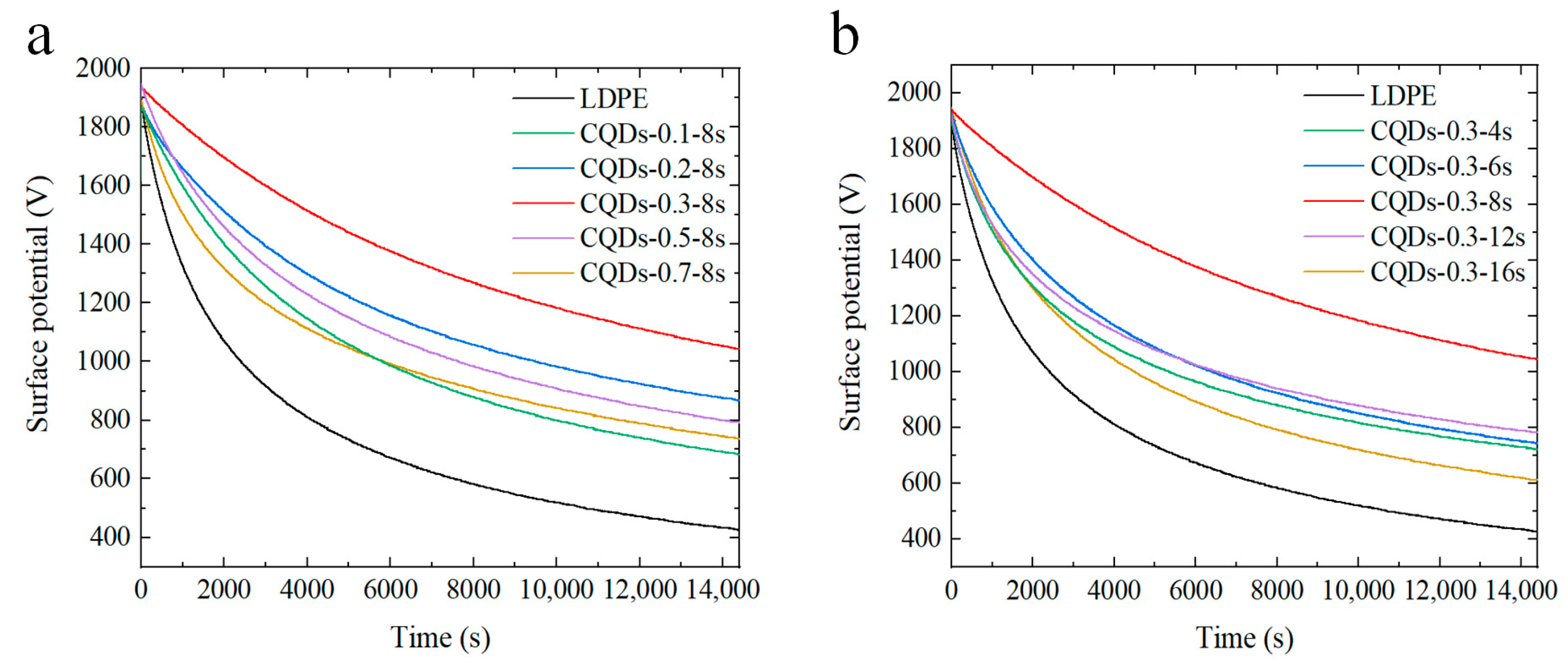
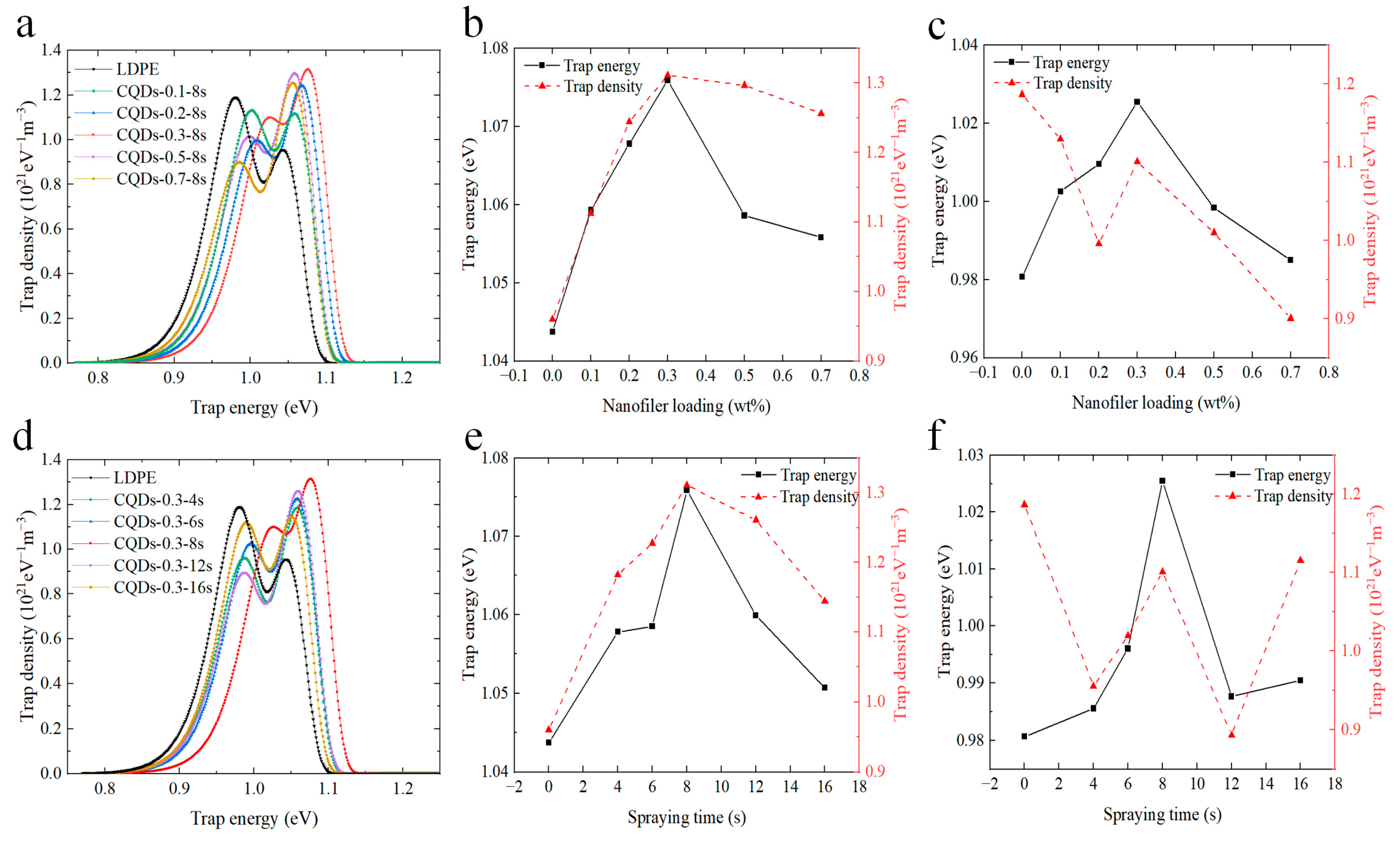
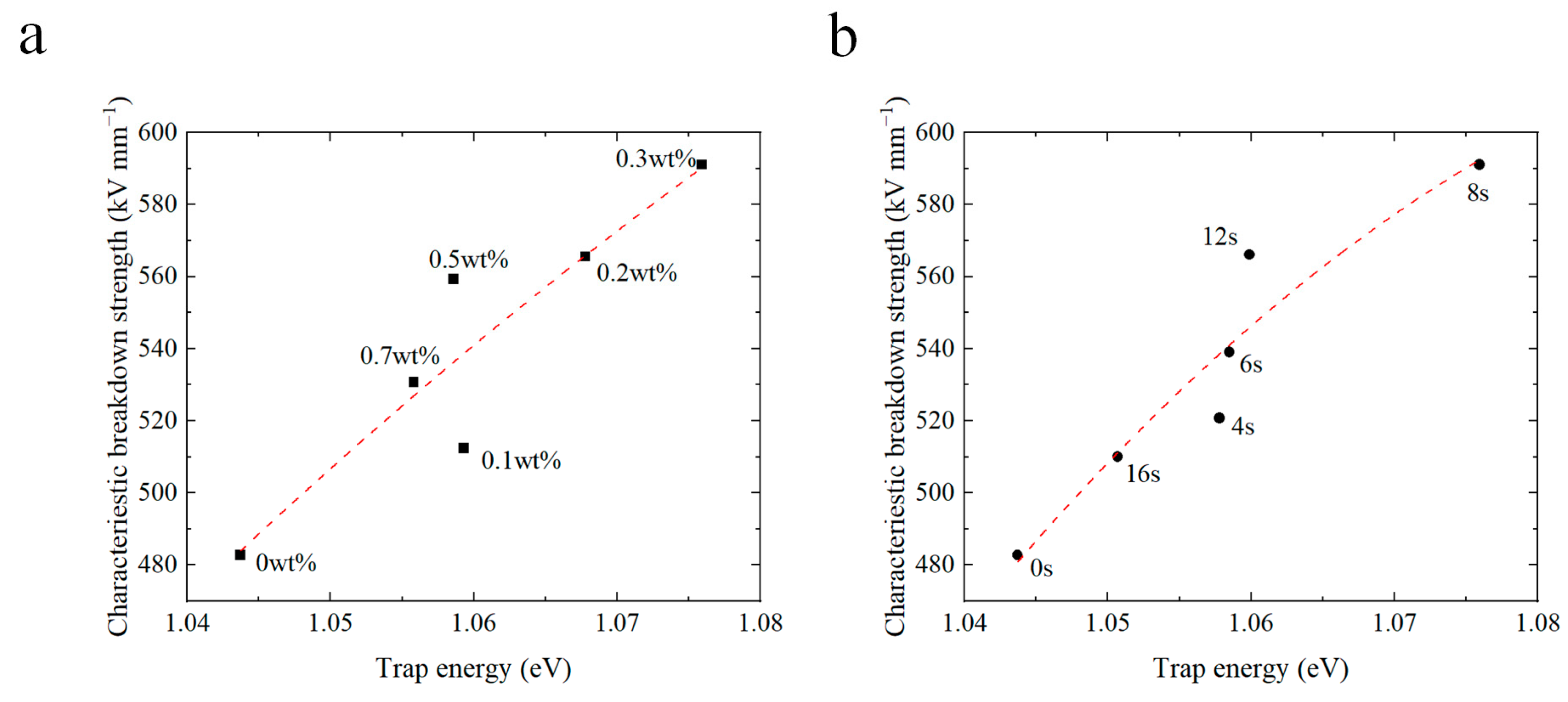
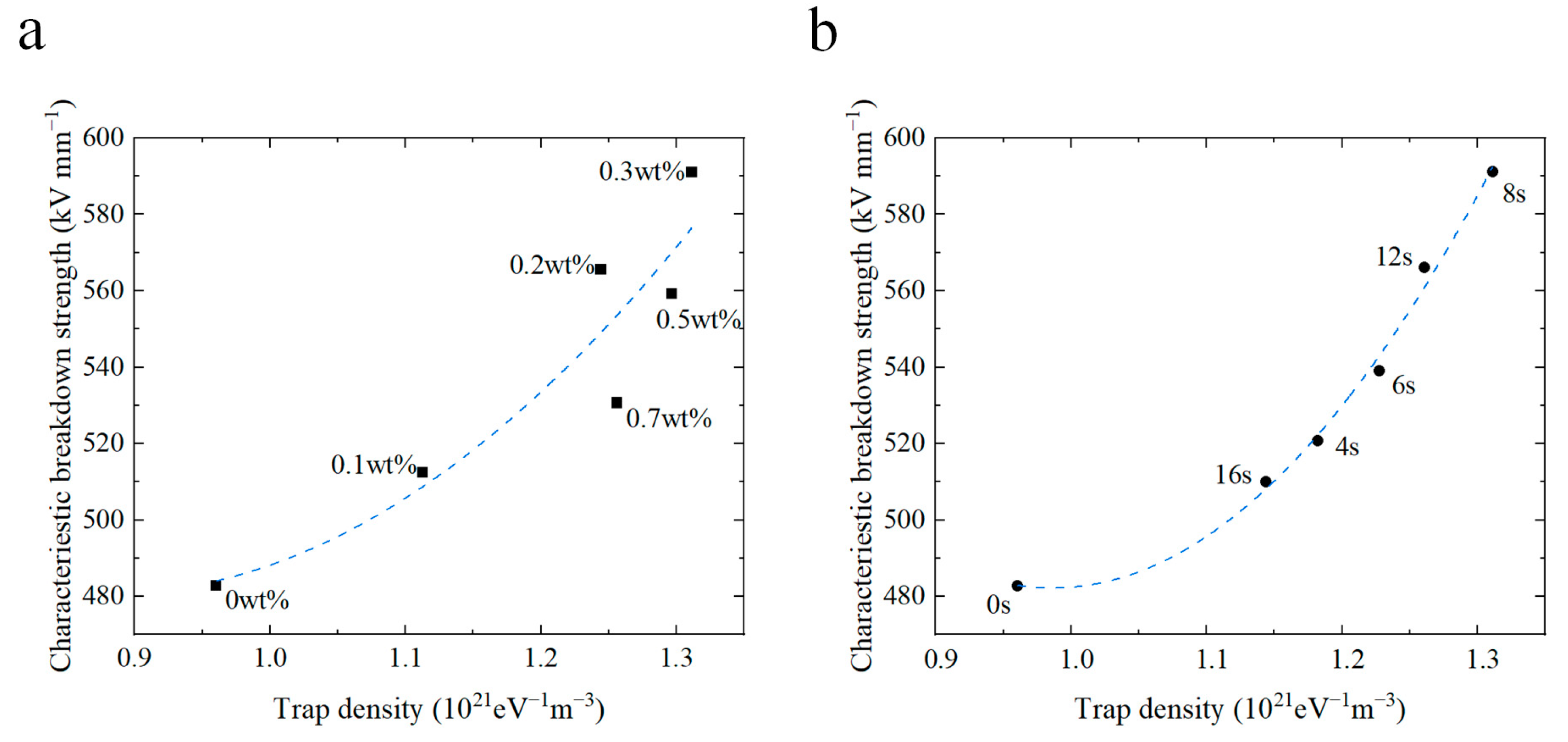
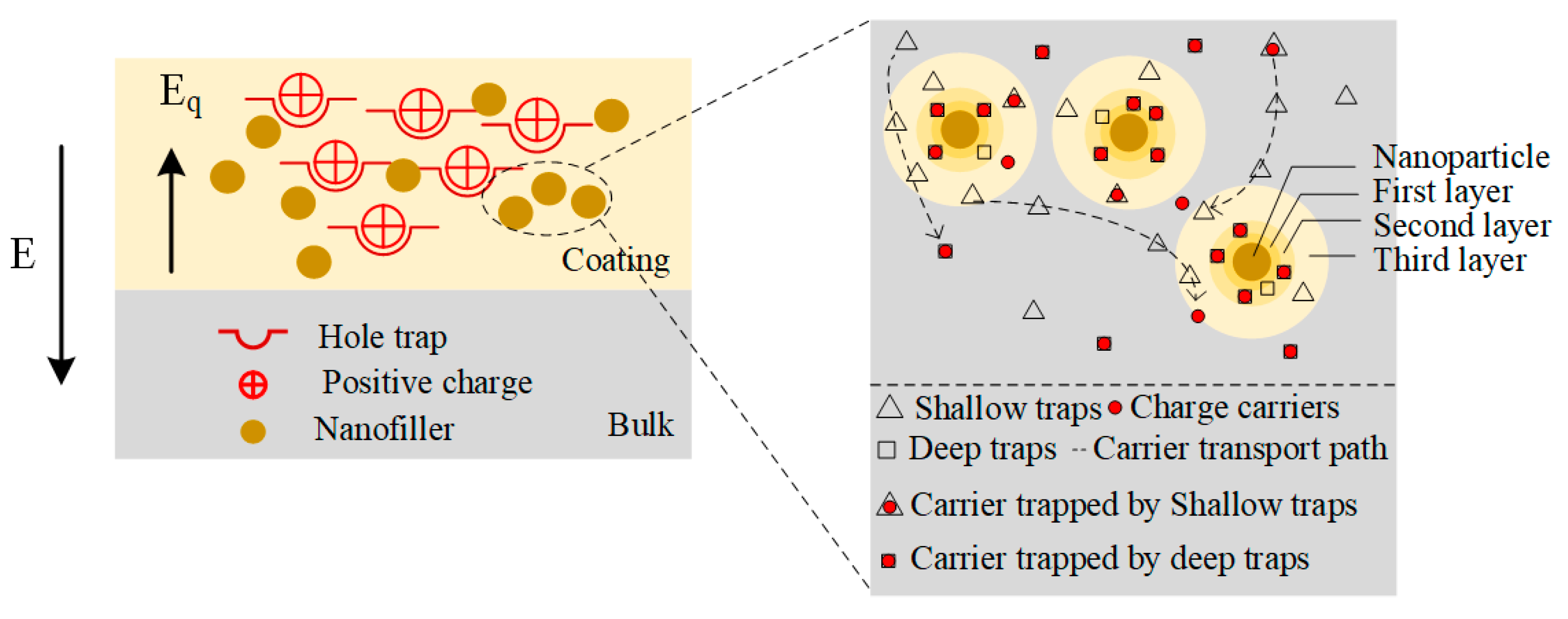
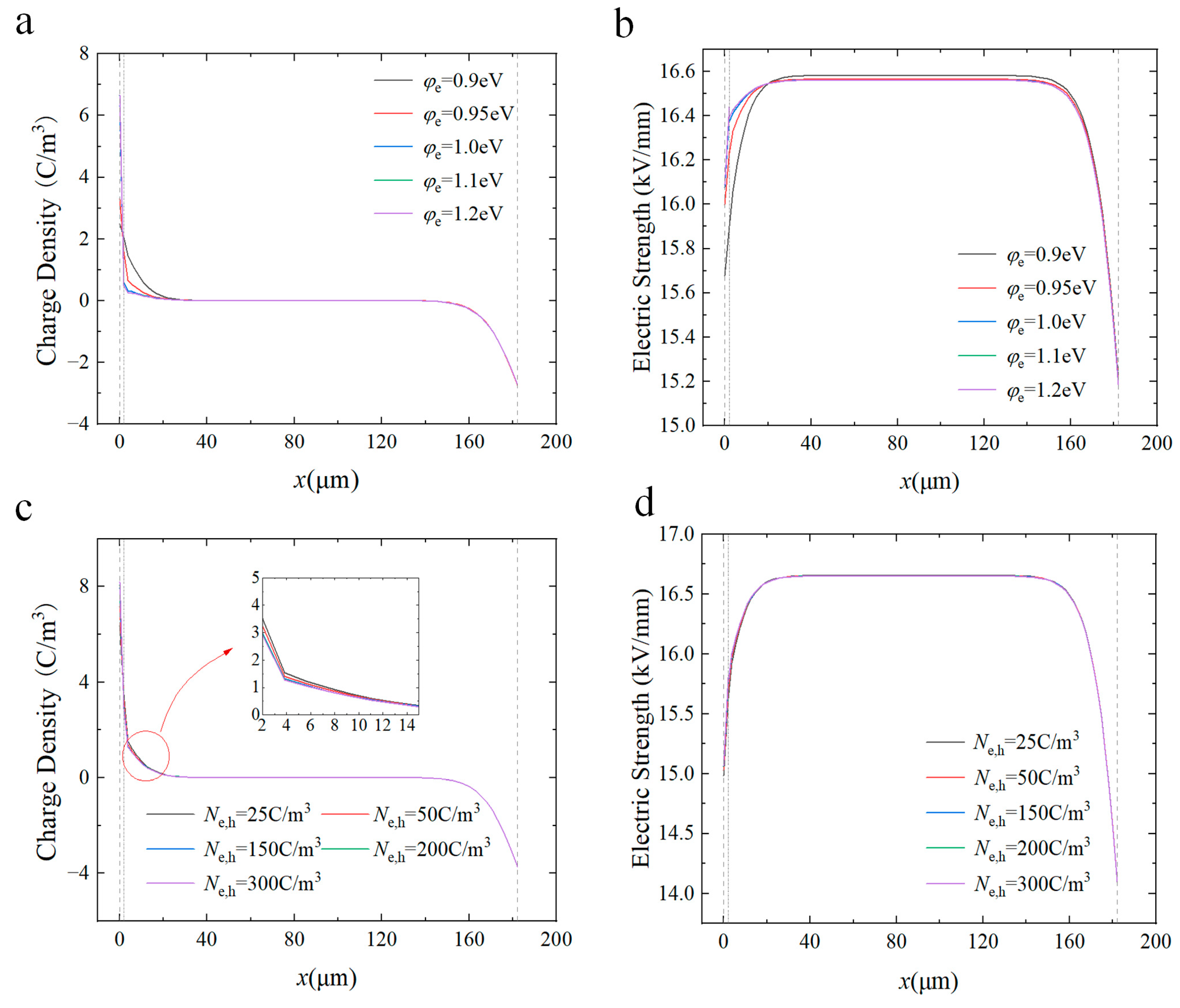
Disclaimer/Publisher’s Note: The statements, opinions and data contained in all publications are solely those of the individual author(s) and contributor(s) and not of MDPI and/or the editor(s). MDPI and/or the editor(s) disclaim responsibility for any injury to people or property resulting from any ideas, methods, instructions or products referred to in the content. |
© 2023 by the authors. Licensee MDPI, Basel, Switzerland. This article is an open access article distributed under the terms and conditions of the Creative Commons Attribution (CC BY) license (https://creativecommons.org/licenses/by/4.0/).
Share and Cite
Wang, J.-X.; Chen, Y.-G.; Chen, J.-M.; Yin, Z.-H.; Chen, C.-S.; Li, Y.-F.; Deng, T.; Guo, X.-B.; Zhu, M.-X. Improved Insulating Properties of Polymer Dielectric by Constructing Interfacial Composite Coatings. Materials 2024, 17, 59. https://doi.org/10.3390/ma17010059
Wang J-X, Chen Y-G, Chen J-M, Yin Z-H, Chen C-S, Li Y-F, Deng T, Guo X-B, Zhu M-X. Improved Insulating Properties of Polymer Dielectric by Constructing Interfacial Composite Coatings. Materials. 2024; 17(1):59. https://doi.org/10.3390/ma17010059
Chicago/Turabian StyleWang, Jia-Xuan, Yong-Gang Chen, Ji-Ming Chen, Zhi-Hui Yin, Chun-Song Chen, Yi-Fei Li, Ting Deng, Xiao-Bo Guo, and Ming-Xiao Zhu. 2024. "Improved Insulating Properties of Polymer Dielectric by Constructing Interfacial Composite Coatings" Materials 17, no. 1: 59. https://doi.org/10.3390/ma17010059




